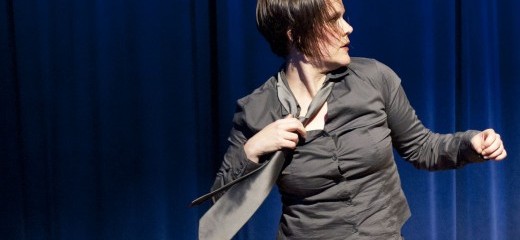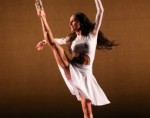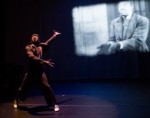
Photo: Tim Richards
Improvisation for all tastes?
By Becca Weber
Often in the field of dance, we use terminology that lacks clear definition. Are you a “modern,” “postmodern,” “contemporary,” or “experimental” artist? What does each even mean? Can you be several at once? In different communities, the same dance may have different labels—what we call “modern” or “postmodern” in the States might be “contemporary” in Europe; while to us, “contemporary” could imply the sort of commercialized “routine” found on So You Think You Can Dance. I, for one, never quite know how to answer when someone asks me what kind of dance I “do.” And I’m sure I’m not alone.
Another such term is “improvisation,” and Falls Bridge, billed as a “new movement, improvisation, and performance festival,” gave audiences a sampling of the myriad interpretations of that word. Audiences were served solid structures that flirted with choreography, free and open-ended interpretations, and works with little design other than spontaneity, while performers ranged from children to adults, novice to mature, and included movers as well as musicians.
Friday evening opened casually; dancers warmed up in the stage space while a full house trickled into Mascher Co-op. The show began with a performance by Falls Bridge creators Nicole Bindler and Curt Haworth, soundtracked by Bhob Rainey. Bindler and Haworth took turns, long limbs leading in linear shapes which dissolved, collapsed, and rebounded into structured forms again. A shared glance linked them across the distance, the first of a few rare moments of connection in their plain-faced duet. The tenuous connection persisted as they picked up bits and pieces--little jumps, energy states--from one another’s movement. These moments of synchronicity evolved into a satisfying end with the two swirling toward another, a pair of gyroscopes meeting.
The seriousness of this opener crashed against the hilarity of Group Motion. Director Manfred Fischbeck dutifully elaborated the structure: each of four dancers would create a tableau based on an audience-suggested theme drawn from a hat. One by one the dancers set up their colleagues. Watching the dance unfold was enjoyable. We had some idea where they were going, but not even the dancers themselves knew how they’d get there. And they did not make it easy on each other. The audiences’ giggles became full-out guffaws as Hedy Wyland wryly interrupted her cohorts (who were clearly setting up for the third tableau) as she dropped David Konyk with a simple, “I wasn’t ready.” The dancers’ comedy was physical, too: from writhing in awkward positions, to over-dramatic lyricism, to a mock-lapdance performed by Wyland,and then Konyk,just inches from Fischbeck on his keyboard bench. Eventually, reluctantly, the fun and games concluded with an out-of-breath Lindsey Browning begging the others to assume their fourth position, “Please! ...Now! I’m tired of this.”
The somber/humorous dichotomy was mirrored when Harmonica Semis’ solo met Christina Gesualdi and Annie Wilson’s duet-ish trio with accompanist and sometime-participant Julius Masri. In Semis’ commanding solo, every moment was new. Her furling, unfurling, and tracing cylinders of space was interrupted only by the intensity of her gaze in moments of stillness, as when she studied her shadow on a bare wall or peered into the barrel of a stage light. Semis’ accompanist Andy Hayleck’s electronic pops and synthetic bellowing provided the soundscape, filling her stillnesses as we observed her body’s thinking reflected in her pensive face. Alternately, Wilson and Gesualdi’s slack-jawed mouthing of words, jaunty leaps, and witty banter had at least half the audience in stitches. The finale featured guest artists Rebecca Bryant and Margaret Peck, with locals Marion Ramierez, Megan Mazarick, and Mason Rosenthal in a nuanced offering that straddled both lines. Turn-taking solos became difficult weight-bearing partnering, while accidental falling led into overjoyed jumping.
Saturday night provided similar contrasts, and featured pieces that were more ideological but perhaps less rich in movement investigation. The evening felt more spontaneous, less mature, more raw, less structured. The menu included political works--Rebecca Bryant’s feminist “Suite Female: Part IX” implied the constraints of female domesticity, while Jaamil Olawale Kosoko’s “Stallion Study #2: Revenge of the New Negro” confronted uncomfortable issues of race.
The standout performance of the evening was “Resident Artists: dancing/familiar,” a collaboration between artist/parents/partners Margaret Paek and Loren Dempster with Marion Ramirez and JungWoong Kim and the children in their care: Eleanor (Nona) Dempster-Paek, Minkyong Ji, and Ari Kim-Ramirez. While the piece was clearly structured, all bets are off when a 2- and 3-year old are involved.
Natural performers, Nona and Ari loved the spotlight, and if laughter is any measure, the audience loved them back. Ari exclaimed, “I have done it!” after scaling the small mountain of Ramirez’ outstretched back. Later, Nona insisted on removing her shirt, whipping Kim in the face with it, and then chasing him, demanding “I NEEEEED it!” as he slid away, her shirt in hand. Their improvisation was gloriously natural, reminding me of how much professional “grown-up” improv could benefit from this level of unabashedness.
The juiciest moments came when the adults echoed the kids (Ramirez climbing and balancing atop a squatted Kim), or when their efforts were interrupted by children wandering astray. The piece provided an honest look at the joys of parenthood—the inspiration of seeing the world anew through childrens’ eyes—as well as the travails of juggling the hectic double life of the parent-performer.
This juggling act is much like the craft of improvisation: a little messy, a little rough around the edges. It can mean a simple or complex structure, or none at all. Sometimes magically surprising, others frustratingly blasé, yet others painstakingly predictable. Improvisation in performance challenges dancers to walk a fine line--between making new discoveries in real-time and providing something that is engaging and valid enough to warrant audiences’ time and money. There are many pathways there, and none are guaranteed. Falls Bridge offers performers a chance to try out any and all of those pathways and audiences a chance to witness that trial-and-error...or success.
Falls Bridge, presented by Mascher Space Co-op, Nicole Bindler, Curt Hayworth, Philly PARD, and University of the Arts. Mascher Space Co-op, January 19, 2013; PARD, January 20, 2013.
By Becca Weber
January 28, 2013







.png)


